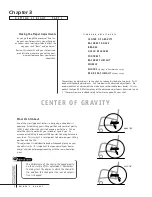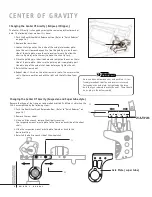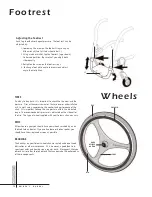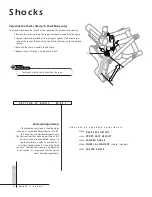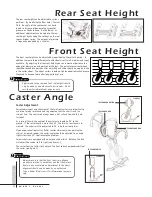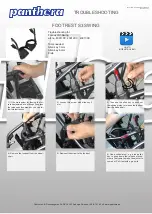
This is a dangerous maneuver and we do not recommend its use without assistance.
The safest way to operate the chair is on level floors that are free of obstacles. Whenever possible use
a ramp to enter or exit a facility. Keeping your hands on the push rims will allow you to maintain max-
imum balance. Do not try to force yourself over an obstruction by propulsion and never use the sides
of a doorway to pull yourself through a passageway.
It is best to avoid reaching or leaning forward when operating your wheelchair. If circumstances arise
that make leaning forward unavoidable you should:
1. Position the casters in the forward position.
2. Maneuver your chair as close to the desired object as possible.
3. Secure yourself with one hand by holding on to the arm rest or rear wheel.
4. Do not lock the rear wheels.
5. It is best to avoid applying pressure on the footrest.
When traveling up or down a hill, it is recommended that you:
1. Maintain a straight course.
2. Never turn on a hill due to the danger of toppling.
3. Avoid stopping, it can potentially cause you to lose control of the chair.
4. Maintain a slow and controlled speed, by applying steady pressure on the
push rims.
5. Do not use the brakes to slow down or stop the wheelchair, this could cause
it to seize up, causing you to lose control.
6. Whenever possible, utilize help from an assistant while navigating inclines.
It is important to note that hills and slopes can be hazardous, even with the use of
anti-tippers.
W H E E L I E
D O O R WA Y S
E X T E N D I N G , R E A C H I N G O R
L E A N I N G
N AV I G A T I N G I N C L I N E S
DECLINING SLOPE
BANKED SLOPE
INCLINING SLOPE
When negotiating curbs it is suggested that:
1. Whenever possible get help from an assistant (if you have assistance make sure that your
chair is equipped with push handles).
2. Avoid hard impacts when descending a curb. A hard impact could adversely affect the chair.
3. If being assisted, the chair should be lowered, by gently rolling the rear wheels down the
curb, from a backward position.
4. Never try to scale or descend curbs that exceed a normal height.
When going up or down a staircase you should:
1. Always use two or more assistants.
2. One assistant should be positioned at the rear of the chair and one assistant should be
positioned at the front of the chair.
3. Always secure the chair by holding non-detachable positions on the frame.
4. When ascending a staircase, position the chair backward.
5. When descending a staircase, position the chair forward, tilt the chair back and roll down
one step at a time.
6. The assistant to the rear is always in control.
7. The chair must have push handles when negotiating stairs.
Never use an escalator for transport, use an elevator.
Always use extreme caution when crossing streets. Reflective tape on the chair or your clothing will
make you more visible to drivers.
Check local laws regarding wheelchair use as they vary from state to state.
C U R B S
S T A I R S
E S C A L A T O R S
S T R E E T S
S
A
F
E
T
Y
T
I
P
S
1
O W N E R ’ S M A N U A L







